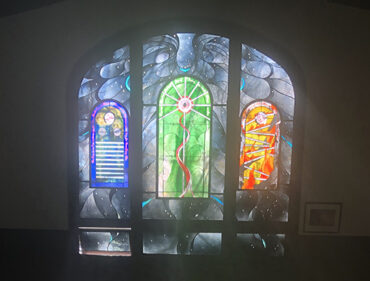Article: Bridging the Worlds between Life and Death with Shamanic Practice
By Isa Gucciardi, Ph.D.
As part of Tarka’s “On Death” issue, I have been asked to speak about the approach to death that my tradition, that of shamanic practice, follows. Some of the questions I have been asked to address are: What is death from the perspective of your tradition? What transmigrates, if anything, from the perspective of your tradition? What key text, verse, or poem offers insight or clarity around the experience of death? How has an experience of death in your life informed your teaching? What is a practice that directly addresses our relationship with death? I have tried to address all of these questions in this short exploration of the shamanic worldview regarding death.
In his book about the Australian Aboriginal experience, Voices of the First Day, Robert Lawlor offers a statement regarding Aboriginal views about death which are reflective of a larger, more general shamanic worldview. He says, “Death, in the Aboriginal view, is not a termination or a dislocation from this world to another; rather it is a shift of the center of one’s consciousness to invisible, subjective layers that are substrate to, and involved within, the natural world of mind and matter.”
There is a lot to try to comprehend in this statement. This is because the shamanic worldview in general, and the relationship between life and death within it in particular, is so foreign to Western notions regarding these matters. We must shift internally in order to understand what he is saying, and we must shift internally in order to understand the shamanic orientation to the world. The Earth is at the center of this orientation. In shamanic practice, there is a deep sense of union with the Earth. Shamans strive to know all its expressions, and recognize the Earth as a guide toward wholeness and integration. Ultimately, this wholeness and integration is expressed in the relationship between life and death. From the most deeply articulated shamanic perspective, there is no difference between life and death. Death is not, as Western cultures posit, an empty chasm with no connection to life. Life and death are woven together and are both part of an inseparable whole. This view is well-expressed in the Yokuts prayer:
With the great mountains
With the great rocks
With the great trees,
In one with my body
And my heart.
Do you all help me
With supernatural power?
And you, Day
And you, Night!
All of you see me
One with this world.
The Yokuts people are Native Americans, native to central California. They, like other shamanic cultures, share traditions of initiation which are designed to help familiarize the initiate with the mysteries of their lives, including the confrontation with death. In shamanic cultures, initiation rituals and ceremonies are conducted to provide this education. Initiations themselves are intimately tied with change. They bring the initiate from one state of being into a new state of being. Initiations accomplish this task by putting the initiate through a series of experiences that challenge them in particular ways, and bring them into new ways of thinking and being. The initiate must meet these challenges and overcome any obstacles that present themselves, in order for initiations to succeed in bringing about these changes in a coherent way. Initiates are guided by elders, wisdom keepers and older shamanic practitioners in these processes.
In most shamanic traditions, the initiations around birth and death are considered to be the most important. One of the focal points of these initiations is to create conditions so the spirit of the initiate can learn to move at will between the world of the seen and the world of the unseen. In order to do this, initiates must engage in practices that heal and integrate the body, mind, and spirit during life. When this task is accomplished, the spirit can shift more easily into the world of the unseen at the time of death. Shamans learn to do this – and they learn to help others do this as well. This is the essence of the shamanic path.
One of the ways in which shamans are plunged into initiations around death is to actually have a near-death experience. It is not at all uncommon for someone to be called to the path of the shaman through this kind of experience. In traditional settings, seasoned shamanic practitioners might surround the person emerging out of such an experience, and set them on a path toward training in the broader requirements of shamanic practice. This was the case with me. I have, in fact, had several near-death experiences over the course of my lifetime. I don’t talk about the particulars of these experiences, and I rarely mention that they have been part of my formation as a shamanic practitioner. But these experiences are absolutely fundamental to my call to the shamanic path, because I have been plunged so utterly into the heart of the natural world as a result of my spirit being separated from my body. When this happened, I encountered the deeply compassionate, unperturbable spirits of the plants and of the Earth who cared for me during death, and returned me to life. They have continued to guard over me every step of my life, and teach me through every stage of my development. They are my primary teachers. Their priorities are my life’s priorities.
Like them, one of my priorities in this lifetime is to teach. As a shamanic teacher, my first task is to initiate students into the numinous world of the unseen powers of the Earth so they can have their own encounter with these remarkable forces on their own terms and in their own way. The doors to this way of seeing my near-death experiences provided me can also be opened by other means. These include the doors of the shamanic journey, the ingestion of psychotropic plants, dreams, death itself, and other methods that alter the usual conscious-mind state of awareness. The conscious-mind state of awareness, where most Westerners tend to focus, generally filters out the larger reality of the shamanic worldview. In my teaching, I open the doors to this worldview by introducing students to an alternative way of seeing through the shamanic journey. This is a process where the state of consciousness shifts in response to rhythmic sound. As this shift occurs, the filters of the conscious mind weaken. Westerners often need an intermediary to help them understand the nature of the reality that opens beyond those filters. This is a service I can provide.
As a teacher, I help students develop trust in the normally unseen natural forces that reveal themselves through the journey. I help them recognize how these forces communicate, and help them see that they are meeting the student exactly where they need to be met. I help them see how these forces, which can be called guides, helping spirits, or teachers, can help the student transform what needs to be transformed within them, to heal the pain that calls them to the work. There is much work to do with every student. I have developed a curriculum through the work of the Foundation of the Sacred Stream, which escorts each student through the path of their pain into the path of their heart, and into wholeness. I do for my students what my inner guides have done for me with as much seriousness, joy, sense of responsibility, and love as they have shown me.
As I mentioned, another way that people are called to the shamanic path is through an encounter with the helping spirits revealed by psychotropic plants. Plant spirit medicine can provide invaluable teachings, as plant spirits can be very helpful in preparing people for death. This is because they can take the initiate back and forth across the frontier between life and death. One of the better-known plant medicines, ayahuasca, a blend of plants that often includes the Banisteriopsis caapi vine, is called the ‘vine of death’ because of this capacity. The plant medicine path, which has been fundamental to bridging the worlds between life and death in many shamanic traditions for millennia, is one that has become better known in the West in recent years. Yet, in the West, psychotropic plant medicines are often ingested by those who do not understand the context in which the spirits of the plants operate. Unfortunately, they often do not have proper guidance to understand the nature of that context either. A big part of my work is now in educating those who have taken this path of initiation without the proper preparation, in order to help them integrate the teachings the plant spirits provide.
As the work with plant medicine has become more widespread in the West, Western scientists and politicians are revisiting their initial rejection of the validity of the alternative worldview that hallucinogenic substances can open. Scientists at Johns Hopkins have made much of the potential beneficial effects that psilocybin, the psychoactive chemical in some hallucinogenic mushrooms, can provide. In 2018, they began experiments in which they administered psilocybin to subjects coping with the stress of a fatal diagnosis and end-of-life issues. Scientists tested the capacity of this substance to alleviate the symptoms related to that stress. The subjects’ overarching experience as a result of their encounter with the expanded worldview that opened to them with psilocybin was positive. Most experienced a significant reduction in depression and anxiety. Many reported a diminished fear of the dying process. This, of course, provided an improvement to the quality of their lives as they confronted their illnesses. This is the same information that shamans have provided those they assist since time immemorial.
The potential for psychoactive plants to reach into the hearts and minds of people who may have lived their lives with very little awareness of the sacredness, magic and beauty of the Earth is great. So too is the ever-expanding interest in shamanic practice in general. As I have said, although shamanic practices differ in form from culture to culture, their essence is quite similar. That essence, that power, is the power of the Earth to heal, to guide, and to create wholeness. Anyone who approaches the Earth with humility and respect can receive its teachings. As people are initiated into the power and wisdom of the Earth through any of the doorways she offers, they can achieve wholeness. They can step into a new relationship with life – and a new relationship with death. That relationship is one that shamanic practitioners have always understood. This relationship is beautifully expressed in the prayer from the Omaha people, Native Americans from the northern plains of North America:
from Earth, the Mother.
Naked you return to her.
May a good wind be your road.
Therefore, we do not lose heart.
Though outwardly we are wasting away,
yet inwardly we are being renewed day by day.
For our light and momentary troubles
are achieving for us an eternal glory
that far outweighs them all.
So, we fix our eyes not on what is seen,
but on what is unseen.
For what is seen is temporary,
but what is unseen is eternal.




